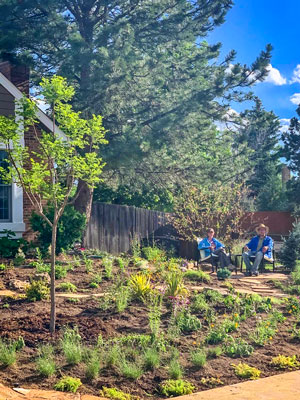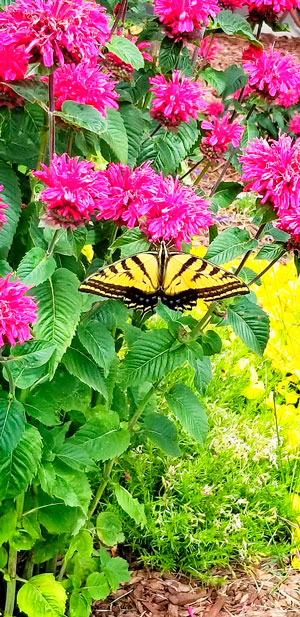Hello butterflies, bees and birds
GOODBYE LAWN…
By Lisa Nicklanovich; courtesy photos

Leigh and Eric Houston relax after a several week project converting their front lawn into a xeriscape garden. The plants are beginning to take root, and in a short time the yard on Brixham Court will be filled with color and life. (Note: The word “xeriscape” derives from the Greek word for dry, “xēros.” The concept of xeriscaping was coined and trademarked by Denver Water, the city of Denver’s water department, during a drought in the late 1970s.)
Community residents Leigh and Eric Houston have a front yard that looks a bit different than most of our front yards; while most of us have grass lawns, the Houston’s recently replaced theirs with a xeriscape yard.
Xeriscape refers to a landscape that is meant to save water, time, and resources but is also beautiful and encourages visitors such as birds, bees, butterflies and moths. Leigh pointed out that with all the development going on in our area, there has been a loss of habitats for many insects, which we depend on for a variety of reasons. Leigh said, “Insect life is the bottom rung of our food chain and if we disrupt that bottom rung, there are disturbances all the way up.”
With their garden, the Houstons have provided a great variety of plants that appeal to a variety of species. “I wanted biodiversity versus a single crop of lawn so I could encourage more birdlife and insect life, and wildlife in general, which we love here in Colorado and is part of why we live here,” Leigh exclaimed.
Leigh and Eric had the knowledge and experience to take on a project of this scale. Leigh is a master gardener and landscape designer. Eric is an engineer who re-routed their sprinkler system, laid flagstone for their patio area, and helped with the hard work involved in this project. Leigh pointed out that not only is plant selection and location very important, but there are hydration zones to consider and ensuring that water is diverted away from the foundation of your house.
So, hire an expert for a big xeriscape project, but Leigh said she thinks any homeowner could do this on a smaller scale. “It doesn’t have to be an all or nothing thing. Create something nice to look at all year round,” Leigh said. For where to start, Leigh suggested taking a small section of lawn and replacing it with water-wise plants that are native and/or naturalized to Colorado, such as species of penstemon, bee balm and antennaria. The website www.plantselect.org is a great place to get expert advice on which plants will work best in your yard, Leigh said. To suppress weeds and conserve water, lay mulch around the plants.

This swallowtail butterfly on a bee balm plant was captured on camera in a yard in a nearby neighborhood. It exemplifies the kind of visitors that the Houstons are welcoming to their xeriscape yard.
Leigh cautioned that xeriscaping doesn’t mean zero water or zero maintenance. With more plants than hardscape, there will be some tending, but Leigh said she enjoys this yard far more than watering, fertilizing and mowing the former lawn. More hardscape such as rocks, boulders, and pavers means less water and work but also less biodiversity.
“Watching things grow, working with your hands, and sitting back and enjoying the diversity move in and seeing the fruit of your labor and the fruits of their nutrition,” said Leigh, is the payoff for this project. While they relax in the shade on their patio, Leigh and Eric are seeing big bumblebees, swallowtail butterflies and birds visiting their new habitat.
For more information, visit the Castle Pines North Metropolitan District website at www.cpnmd.org. You will find information about xeriscaping, water conservation, alternative lawn ideas and rebate programs.